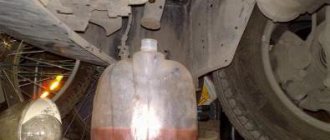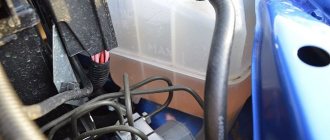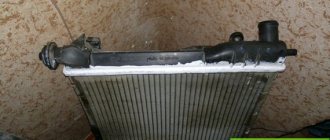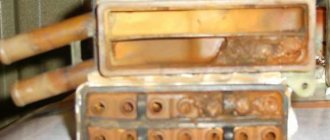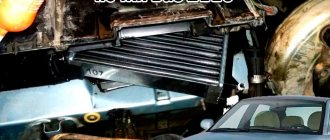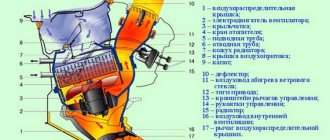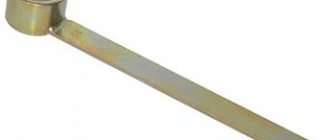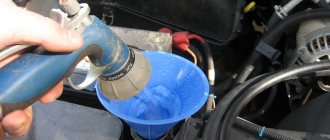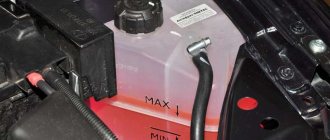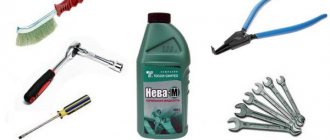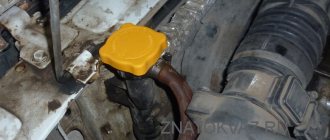The cooling system is an important part of a modern car. Its overheating can cause expensive repairs. That is why during operation of the machine it is necessary to regularly monitor the condition of the cooling system.
Using a car reduces the performance characteristics of engine cooling fluid (antifreeze, antifreeze). This can cause foam to form in the system, which will cause corrosion of the cylinder block, thermostat, radiators and damage to the water pump mechanisms. In this case, nothing will help except high-quality repair of the cylinder block. This is why you should replace the coolant at the intervals specified by the manufacturer.
How to drain coolant
In order to completely drain the coolant from the system without any residue, it is desirable that the front of the machine is lower relative to the rear. For example, the rear can be jacked up a little.
Now let's start draining the old antifreeze before replacing it with a new one. Most car engines have a tap or a special drain plug in their lower part through which the coolant is drained. In addition to the cylinder block, antifreeze will also need to be drained from the radiator and expansion tank.
To do this you need:
- Loosen the expansion tank cap - this will allow the coolant to drain faster.
- Unscrew the drain plug and drain the antifreeze from the engine cooling jacket into a suitable container placed under the drain hole.
- Unscrew the drain valve or lower radiator cap and drain the old coolant from it in the same way.
The pressure of the drained liquid can be adjusted by unscrewing or tightening the cap of the expansion tank. After draining the coolant, be sure to screw all drain plugs back in.
How to drain and replace antifreeze on a VAZ?
Replacing antifreeze in the engine cooling system is an event that is performed at certain intervals in order to maintain efficient operation of the cooling system. Today you will learn how to drain and change antifreeze on a VAZ 2107 and why this is done.
Why do they change antifreeze?
The cooling system of many modern cars is liquid. That is, heat transfer is carried out by a liquid that circulates through a system of tubes and, cooling in the radiator, returns back to the engine to receive a new portion of heat. The VAZ 2107 engine cooling system initially used water, but later, due to reduced resistance to negative temperatures, it was replaced with antifreeze.
Antifreeze, compared to water, has good resistance to frost and does not freeze at all. In addition, it is not a source of scale, which means it does not clog the cooling system.
In the process of constant temperature exposure, antifreeze may lose its properties. That is, first of all, its boiling point decreases and becomes equal to the boiling point of ordinary water. Secondly, such fluid can easily freeze and cause a cracked reservoir, and in the worst case, a cracked cylinder block. That is why antifreeze must be changed at least once every six months during seasonal vehicle maintenance in order to avoid undesirable consequences.
How to drain antifreeze correctly?
In order to drain the antifreeze, it is not enough to simply turn off the taps. To begin with, you need to understand that antifreeze is a toxic substance, which means it can pose a danger to humans if handled incorrectly. In this regard, there are a number of rules that must be followed:
To properly drain the antifreeze, you need to prepare an empty container with a capacity of at least 10 liters. The most desirable condition is the presence of a wide cavity and not a deep bottom. The fact is that there is not enough space under the car in height, but there is enough width. That is why many drivers use the most ordinary aluminum trough for these purposes.
As soon as you have prepared everything you need, place the car on a flat surface, or best of all, on an inspection hole and place a trough under the radiator. Open the hood and unscrew the cap from the expansion tank. This is necessary to make it easier for the liquid to come out. After this, unscrew the tap located on the radiator.
If you have an old-style copper radiator installed, then this tap acts as a fan activation sensor and is designed for a 30 wrench. To remove it, you first need to disconnect the contact wires from it and then unscrew it. Now all that remains is to wait until all the coolant has completely drained out of the radiator. To speed up this procedure, you can shake the front of the car.
Next in line is the cylinder block. On the side of the spark plugs there is a special drain bolt of 13, which must also be unscrewed. But before you do this, you must first move the trough under the engine and then unscrew the bolt. Wait until the old antifreeze drains from the engine and move the trough to the side. Screw all drain valves and plugs into place.
How to choose antifreeze
Before replacing antifreeze, you must first buy it. Oddly enough, this can also cause problems. After all, it comes in different brands, as well as different characteristics, and not every car owner knows which of them are suitable. Here are the important points to pay attention to when choosing a coolant:
- Marking. First, let's look at the conventions. Any antifreeze is marked with a letter and a number. There can be two letters: “A” - ready to be poured into the cooling system, “K” - means a concentrate that requires dilution before use. After the listed letters, the freezing temperature is placed on the Celsius scale - 40, 65 degrees, etc. After this, at the end, there may be the letter “M”, which indicates the presence of additional impurities and additives. Sometimes the label just shows a name and a number.
Antifreeze markings
There is also some “unofficial” but common marking introduced by Volkswagen.
In accordance with it, antifreeze is divided into groups G11, G12 (G12+, G12++) and G13. G11 - mainly green antifreezes, which contain organic and chemical additives;Antifreeze G11
- G12, G12+, G12++ —red antifreezes of various shades, they are almost completely organic;
Antifreeze G12, G12+, G12++
- G13 - mostly purple or yellow antifreezes, more modern and safer.
Antifreeze G13
Not all antifreezes of different markings can be mixed with each other . In any case, the seller will tell you about the product you are buying, so there will be no problems with this.
Mixing antifreeze of different markings
- Manufacturer. You also need to pay attention to this, since you may get a defect that will ruin your engine. To prevent this from happening, you need to buy antifreeze from trusted or at least well-known companies. For example: Liqui Moly, Lukoil, Hepu, Motul, Mobil.
It is recommended to buy antifreeze only from proven brands
- Detection of counterfeits. It often happens that recently purchased antifreeze very quickly became unusable or, more simply put, you came across a fake. But how to choose a good product? Easily! There are basic parameters that are common to all coolants. First of all, this is the color: it must match the markings (the standard color is blue) and be transparent, but only slightly. In addition, the consistency of the substance should be slippery and resemble vegetable oil. You also need to pay close attention to the label. At factories they glue it evenly and indicate GOST and markings on it. By the way, all domestic manufacturers comply with these requirements. The brand must be in line with GOST. In other cases, you will most likely buy a defect.
Original antifreeze (left) and fake (right)
We recommend: Car repair. When should you replace your car's brake pads?
Another important point worth mentioning is the name. The coolant container may be labeled “Tosol” or “Antifreeze”. What is the difference between them? Nothing! Simply, the word “antifreeze” can be used to describe any substance that is capable of removing heat, and antifreeze is produced exclusively for cars and, in particular, for internal combustion engines, since it has anti-corrosion properties, thanks to which the block and cooling system are not damaged.
How to replace antifreeze
Choice of antifreeze.
Replacing antifreeze in a modern car is a rare, but responsible procedure.
The main thing is to choose the right product, in accordance with the requirements of the car manufacturer. The fact is that a modern car is assembled like a kit, from components produced by different companies and from different materials, but the general requirements for the result are formed by the main car manufacturer. Based on numerous factors: the materials used, requirements for the durability of automotive components, operating conditions and region, and much more, the type of antifreeze is selected. Therefore, most car manufacturers have individual preferences for coolant and the choice must be made according to these requirements. Such requirements can be formulated very generally or very specifically. An example of such requirements: Chinese car manufacturers recommend using antifreeze based on monoethylene glycol, there are hundreds of varieties, and the VAG concern prefers TL-774 C, an additive package for which is made by only two companies in the world.
So, the first thing to do is open the instruction manual and then go to the store
. The color of antifreeze is not a criterion for selection.
Any process fluid must be colored, but the color can be any, so antifreeze manufacturers choose not a specific color, but the color that is most durable in use and different from other products. You can read more about the features of antifreeze here.
Antifreeze replacement procedure.
It is preferable to work in a room with good ventilation, but you can also work outside if the temperature is comfortable and there is a flat horizontal area to place the car. It may be necessary to remove the lower protection of the engine compartment to access hoses and taps. Some cars are equipped with both a drain plug on the radiator and taps (plugs) on the water jacket of the cylinder block. If there is no such service, then to drain the old antifreeze you need to remove the lower radiator pipe. But before draining the old fluid, you should flush the cooling system, in which scale and sludge accumulate from the decomposition of the old antifreeze additive package over time and temperature. You also need to take care of draining the old antifreeze; it should not fall into the ground or water bodies, as it is poisonous. An old basin with a capacity of at least 10 liters is suitable for draining.
Flushing the cooling system.
A special Kühler-Reiniger cleaning additive is added to the radiator, just like washing powder is added to a washing machine.
Important: not on all cars it is possible to add flushing to the expansion tank; it must be poured directly into the radiator. Next, the engine should be started for 20-30 minutes after the thermostat opens. During this time, the active components of the flush will spread throughout the system and the contaminants will become dissolved or suspended. By draining the old antifreeze and flushing, contaminants will be removed from the engine. But it is impossible to drain the liquid from the cooling system dry; more than a liter of old liquid may remain in the “stove”. Therefore, after flushing, you should fill the system with distilled water, run the engine a little and drain it again, this time with the remnants of antifreeze and flushing. It is advisable, although not necessary, to purge the system with air to remove any remaining liquid as completely as possible. This simple flushing operation restores the performance of the cooling system, the efficient operation of the stove and extends the life of fresh antifreeze, which does not have to wash the system and absorb old contaminants.
Filling with fresh antifreeze.
Antifreeze comes in ready-to-use and concentrate forms. When purchasing concentrate, you should buy the same amount of distilled water. When mixed with the concentrate in a 50:50 ratio, the pour point of the mixture should be -40°C. There is one subtlety. If you have flushed the cooling system and there is some water left in the system, then there is no need to mix the concentrate with water in advance. In this case, you must first fill the system with the required proportion of concentrate, and only then add water until it is full. That is, if 10 liters of ready-made antifreeze fits into the system, then first fill in 5 liters of concentrate, and only then add water. In this case, the dilution proportions will be respected.
Important! The system must be filled without air pockets; on foreign cars this can be done without additional steps, but on domestic cars it’s not so simple. You often have to add fresh antifreeze in portions, gradually filling the system and periodically starting the engine. Sometimes, to fill it properly, you even have to put the car upside down so that the air is completely released.
After filling the cooling system with antifreeze, you should check the functionality of the entire system. To do this, warm up the engine until the cooling fan turns on and check how accurately the thermal regime is maintained according to the temperature readings on the dashboard. At the same time, the cabin heater is being tested. With the proper skill, replacing antifreeze in a middle-class car takes about an hour of working time.
Precautions and Tips
When replacing antifreeze, the following recommendations and warnings will help you:
- When deciding how much antifreeze you need, keep in mind that the liquid level in the radiator must reach the lower edge of the neck (if coolant is poured into it).
- When working with antifreeze, be extremely careful and fill it away from children. It is advisable to do everything in the fresh air to inhale as little ethylene glycol vapor as possible.
- If liquid gets into an open area of the body, into the eyes or other mucous membranes, immediately wash the area with clean water.
- Do not allow antifreeze splashes to get on the painted parts of the car body. Especially if you use a liquid with added silicates or based on aggressive ethylene glycol. If coolant gets in, it can corrode the paint, so if this happens, wash the surface with plenty of water.
- The toxic components of the liquid are dangerous to the lives of people and animals, so always close the container with the composition.
- If you use the same antifreeze from the same manufacturer, then flushing the cooling system is not necessary. This procedure is only important when switching to a different type of coolant.
- If you are using a concentrate rather than a ready-made liquid, remember the proportions. In summer, you can add more water to the composition (1:1), since in the heat it will evaporate faster. In winter, you cannot add so much water, as under the influence of low temperatures this will lead to freezing of the liquid. As a result, the expansion tank may burst.
How to drain water from a radiator
How to drain water from a heating battery - this question arises when it is necessary to replace the radiator or remove it for repair (prevention). Draining water from a heating battery is usually done according to a general algorithm, depending on the presence of shut-off valves and the type of heating system in which the device is installed.
Option 1 . Shut-off valves are installed on both connections. In this case, the fittings (taps, valves) are closed. The next step is draining the water. It is made through one of the lower plugs. The non-passable plug is unscrewed using wrenches, a container with low sides is placed under it, and the battery is gradually freed from water. In this case, it is recommended to open the air vent - then the water will not “hang” in the sections.
If there is a tap or valve with a detachable connection connected to one of the lower plugs, water is drained through it. To do this, the union nut of the drive is unscrewed and it is disconnected from the valve body. In some cases, craftsmen unscrew both union nuts at once and disconnect the radiator, transfer it to the bathroom and pour out the coolant. This operation can be carried out with almost all batteries, with the exception of large-sized and heavy ones (especially cast iron).
Option 2. Shut-off valves are installed on one of the connections or are missing. In this case, the process of draining the water depends on the type of heating system in which the battery is used. In autonomous heating, the coolant is drained from the entire system or a separate section of it. To do this, when developing the circuit and installing it, a line for draining water from the lowest point of the complex must be provided. When discharging water into the drain, the shut-off valves on the radiator must be open.
If the radiator is installed in a centralized system, the battery is removed from the coolant with the help of representatives of the management company. To do this, a corresponding application is submitted, and at the appointed time, the management specialists close the heating risers and drain the water from them (at the same time, the water is also drained from the radiator). When emptying the battery of water, it is also recommended to open the air vent.
Water may not drain into the risers if the radiator has a top connection - the coolant inlet and outlet are connected to the top plugs of the device. In this case, the water is drained by unscrewing one of the lower non-passing plugs of the product.
It should be noted that the risers are turned off with the help of the management company either in the off-season (when the heating system is idle) or when a coolant leak occurs. Management companies usually refuse to turn off communications when the heating system is operating.
Option 3. The heating radiator is not equipped with shut-off valves. In this case, all operations to drain water from the radiator are carried out similarly to the sequence of actions in option 2.
Why change the coolant in your car?
Before we move on to talking about the location of the drain plug, it’s worth figuring out whether periodic replacement of antifreeze is really necessary. Yes, this really needs to be done. The reason is quite obvious. Over time, the additives contained in the engine are produced, which reduces the efficiency of the cooler, and the composition no longer gives the desired effect. In turn, overheating of the motor can lead to metal deformation and subsequent problems.
It turns out that draining the old fluid is not just recommended, but necessary, and without fail. In addition to the mandatory replacement in the standard manner, it is also necessary to fill in new antifreeze when installing a new radiator or thermostat. If you have free time and some skills, the car owner can perform the replacement procedure on his own.
Where are the coolant drain plugs?
I would not advise taking the operation of the cooling system so lightly, because its malfunctions can lead to serious expenses. It is better to regularly inspect and, if necessary, change the composition.
However, this is not what we are talking about. As it turned out, many of my clients turn to the service station for a banal and even funny reason - they do not know how to drain the antifreeze of the cooling system, or rather, they have no idea about the location of the drain plug. Let's talk about this in more detail. In the article I will tell you where, what is located and how to proceed when you need to prepare your car for filling with fresh refrigerant.
When to drain coolant
The procedure for independently replacing antifreeze or antifreeze will not be a problem for any car enthusiast. The liquid is drained in the following cases:
- When installing a new thermostat;
- Before the procedure for replacing a car radiator;
- The time has come for a seasonal replacement of new coolant.
This operation is carried out in two stages, since the liquid is contained in the engine cooling system and in the radiator.
Most often, this is something that owners of domestic cars do on their own, so we’ll look at the stages of replacing the fluid using the example of a car we made.
We recommend: 6 reasons why the automatic transmission jerks when shifting into gear
Draining methods
- Traditional, through a radiator. It’s simple: insert the container, unscrew the cap, and drain the antifreeze. A similar procedure is performed with the engine cooling system (provided that a drain hole is provided in the engine). The disadvantage of this method is obvious: it will not be possible to completely drain the antifreeze this way.
- Using jacks. The steps are almost the same: the expansion tank cap is opened, containers are placed, and the plugs are unscrewed. But the rear wheels of the car are jacked up and raised as high as possible. First, both wheels are lifted with a pair of jacks. After 15–20 minutes the car lowers and only the left wheel rises. After another 15 minutes, the left wheel is lowered and the right one is jacked up. After each operation, some antifreeze will leak out of the car. Exactly how much depends on the make of the car and the complexity of the engine cooling system. A similar effect can be achieved during repairs in the field. It is enough to place the car with its nose downhill, and the steeper the slope, the more liquid can be drained.
- Using a compressor. It connects to the engine cooling system and pumps air into it, gradually squeezing out the antifreeze. The method allows you to completely get rid of the coolant, but it is classified as extreme because it is fraught with breakdowns. It is used only by very experienced car owners, since there is no way to assess the level of pressure in the system during this procedure. If the pressure is too high, the plastic parts (expansion tank, pipes, etc.) may simply burst. In addition, not every driver has a compressor of suitable power in his garage.
Flushing the engine cooling system
We have already written in some detail about flushing the engine cooling system.
First of all, flushing has two purposes:
- Cleans the system of dirt and sediment that may interfere with heat transfer and coolant circulation.
- Removing the remnants of the previous antifreeze. This operation is necessary because when mixing different coolants, their components may enter into an undesirable reaction, and thereby weaken the anti-corrosion properties of fresh antifreeze.
Even 20-30 years ago, car enthusiasts used various folk methods to clean the cooling system of contaminants. For example, vinegar essence or citric acid was poured into the radiator. Today, there are many special formulations that cope with this task much more effectively.
Special flushing concentrates are best suited for flushing the system when replacing coolant. Before use, they are diluted with water in the proportion indicated on the package. This is the so-called “soft rinsing”.
Its advantage over compounds poured into old antifreeze is that it acts as a preliminary primer. That is, a certain amount of additives from the solution settles on the metal even at the washing stage, and when you fill in fresh coolant during replacement, it will work much more efficiently in the already prepared environment and will not oxidize.
This completes the independent coolant replacement.
How to add new antifreeze to the cooling system
Once you have completely drained the used antifreeze and flushed the cooling system, you can start filling in new coolant. To do this, you need to carefully screw in the lower holes through which the drain was made and fill in with fresh liquid.
Before you start adding new antifreeze, check that the bolts that lock the drain holes are securely secured. The owner's manual for a specific vehicle usually indicates how much force should be applied. You must be careful about this process so as not to overdo it, but also to prevent subsequent leakage.
Algorithm for filling with fresh coolant:
After using the car for a day, be sure to check the antifreeze level in the tank - you may need to top it up. It is important here to prevent liquid from leaving the expansion tank, since an air lock may form, which will interfere with the stable operation of the cooling system.
In our article we talked about how to drain the antifreeze completely and fill it with new one. But before following our instructions, read your vehicle's owner's manual, as they may suggest other methods for draining and replacing the coolant.
Video on how to drain antifreeze in 15 minutes without loss:
Antifreeze or antifreeze is used in the cooling system of every car. Regardless of whether the liquid is based on ethylene glycol or propylene glycol, it contains a proportion of water and additional additives that have antioxidant, antifoaming and other properties. After the aging of the coolant, the coolant must be replaced, since some of the coolant elements lose their characteristics.
The car's operating instructions contain recommendations for replacing antifreeze, but there are also generally accepted rules that will help you figure out how to fill in antifreeze correctly. First of all, let's look at the frequency of coolant replacement.
How to completely drain antifreeze
Draining antifreeze from the cooling system is not very difficult. You just need to know some points. Why do many people have problems in this situation? This is because the system itself is rather large and the pipes run throughout the entire space under the hood. In general, the machine should have at least 2 cooling circles - small and large, which make the structure work as efficiently as possible. Therefore, when draining, coolant may remain in some hard-to-reach places, causing the freshly filled portion to be wasted.
To avoid this, you need to drain the antifreeze correctly. This is done differently on each car, although the course of action is the same:
- The first thing to do is to park the car level and let it stand for about an hour so that the coolant cools down. This is done because when opening faucets or plugs when hot, there is a high risk of burns. There is no need to explain anything here, everything is already clear.
- Then prepare the dishes for the liquid. Please note that after the procedure you can no longer use it for any purpose, since antifreeze is dangerous and resembles a toxin in its nature. The best option would be a cut plastic six-liter bottle. You also need to keep in mind that there are about 7 liters of antifreeze in the system, so just in case, prepare two at once.
- The main places where fluid needs to be drained are the radiator and cylinder head. You should be careful because these parts contain the most antifreeze. To perform the operation, you need to place a container under the radiator tap and open it. It's usually located at the bottom, but again, it's different for every car. Also, instead of a valve, there can be a regular removable plug. To speed up the process, you can unscrew the cap from the expansion tank and the radiator itself, and also press on the pipes with your hand, as if pumping out the liquid.
- Next, you need to screw on the cap of the expansion tank and turn on the interior heater at full power. This will create pressure, which will cause the antifreeze to circulate, causing the remaining antifreeze to flow out through the tap in the radiator. For the best effect, you can start the engine for 1 minute, but not longer.
- All that remains is to drain the antifreeze from the cylinder block. To do this, you need to find a bolt-shaped plug on it. It will be located at the very bottom, under the ignition system. Take the corresponding key and unscrew it. Please note that some blocks may have a faucet, and some may not drain at all. After the procedure, do not forget to check the suitability of the rubber sealing rings and replace them if necessary. To increase the pressure, you can slightly open the expansion tank cap.
- After the antifreeze stops flowing from the block, the draining procedure is completed. Now you need to tighten all the taps with plugs and pour a special cooling system cleaner into the tank (you can simply fill it with distilled water). It is also sold and used to remove dirt and scale. You need to pour into the system the amount of product specified in the instructions for it - usually 300 ml (if you fill in water instead, then 3-4 liters). Then you should start the engine and let it idle for 10-20 minutes. Then the car should sit for half an hour, and after that you need to start it again for a couple of minutes and after cooling, drain everything according to the above action plan, preferably after that by flushing the cooling system with distilled water.
- After flushing, you need to carefully drain the substance from the cooling system, tighten the tap and plug the hole again with the bolt in the block. That's all. All that remains is to pour a fresh portion of antifreeze into the radiator neck and start the engine.
In general, the norm requires 6 liters, however, this figure can vary greatly for each car. It all depends on the size of the power unit. The best option would be to study the operating manual for your machine, which will contain all these details.
We recommend: Causes of car heater malfunction and its repair
For what reasons is it necessary to completely drain antifreeze?
There are several cases when a complete replacement of the coolant is necessary:
- Coolant boiling or minor emergency repairs . In these situations, it is necessary to add antifreeze to the cooling system, and when it is not available, add water or a different brand of coolant. This is a temporary measure, and at the first opportunity it is necessary to completely drain the coolant from the cooling system and fill in a new one.
- Regular repair work . If it becomes necessary to completely drain the antifreeze for repairs, it is recommended not to use the same coolant a second time, but to fill it with fresh one. In this case, you need to pay attention to its service life.
- The coolant has expired . After two years of operation, a scheduled replacement is necessary - the used antifreeze must be completely drained.
- Loss of coolant performance due to evaporation, oxidation processes, sudden temperature changes.
We recommend
“How often to change antifreeze: increasing engine life” Read more
This is interesting: Is it possible to mix g12 antifreeze
How often does antifreeze need to be changed?
Most manuals for car enthusiasts say that antifreeze needs to be changed every 40-45 thousand kilometers. But, in fact, in this matter you need to start from the type of coolant and its classification. For example:
- Class G 11 fluids, intended for cars manufactured before 1996, have a short shelf life of 2-3 years.
- Antifreeze G 12, recommended for cars manufactured from 1996 to 2001, will last longer - 5 years.
- Coolant G 12+, which is used for cars manufactured after 2001, also has a five-year shelf life.
- Liquids G 12++ and G 13 are rarely used in the domestic automotive industry, but they also have a long shelf life.
Healthy! If you mix different types of refrigerants with the same base, then their shelf life is automatically reduced to 2-3 years.
As you can see, a lot depends on the class of the coolant, as well as on the base on which the liquid was made. Ethylene glycol is toxic and takes a long time to decompose, resulting in corrosion on parts of the cooling system. Therefore, it is recommended to change refrigerants of this type more often. Propylene glycol is considered an environmentally friendly product that quickly decomposes, which is why it lasts longer. Therefore, the fluid replacement period can range from 40,000 to 200,000 kilometers.
To determine when it’s time to change the antifreeze, just purchase a special test strip, which you will find at any auto parts store. Another option is to look at the service book of your car; the coolant replacement period must be indicated there.
To replace antifreeze, you need to prepare everything you need: “fresh” liquid, distilled water for rinsing, gloves, a filling funnel and a container for draining. After this, you need to drain the old coolant.
Frequent situations in which coolant replacement is required
The main situations in which a coolant replacement is necessary:
1. Antifreeze loses its performance properties
During vehicle operation, as a result of oxidation processes, sudden temperature changes, and evaporation, the properties of the coolant change over time. The guaranteed service life of antifreeze is usually no more than 3 years of operation. After this period of operation, it is necessary to replace the coolant.
2. Diluting antifreeze with water or other liquid in emergency situations
Sometimes, as a result of boiling of the coolant or minor repair work, it becomes necessary to quickly add antifreeze, but there is no suitable liquid at hand. In many cases, drivers use water or a different brand of coolant for these purposes. After which a complete replacement of the antifreeze is required.
3. Carrying out repair work
If during the repair process it is necessary to drain the coolant, it is advisable to use fresh coolant for refilling, especially if the service life of the previous one exceeds 2 years. In this case, it is necessary to completely remove the old antifreeze so that it does not mix with the new fluid, worsening its performance properties.
How to prepare for refrigerant drain?
To figure out how to drain the cooler, you first need to become familiar with the procedure. The instructions will help with this. The document describes in detail the location of the drain plugs, including a plug through which antifreeze can be removed. You need to prepare in advance:
After preparation, you should first pay attention to the radiator. All actions begin with him. In the instructions for using the car, you can easily find out where exactly the drain plug is located. Usually, finding a traffic jam is not difficult.
In most cases, the hole on the radiator tank is made of plastic. When the liquid has been drained from the radiator, you can begin to drain the antifreeze from the engine. Typically, the plug is located on the engine block. It must be unscrewed carefully and with the appropriate key. It must be said that all manipulations are performed only on cold engines. Antifreeze is very hot and can cause injury.
What to pay attention to
Don’t forget - if the drained antifreeze is noticeably different in color from its original state, the cooling system definitely needs to be flushed. To do this, you can take special automotive chemicals or use distilled water with the addition of vinegar essence or citric acid. Such a composition can not only wash away the remains of old liquid from the internal surfaces, but also remove a significant part of the deposits that have formed.
Washing continues until the poured composition stops losing color and transparency. Only then can you add fresh coolant without the risk of reducing its performance. A thoroughly washed system allows you to safely fill it with a different type of reagent compared to the previously used antifreeze.
